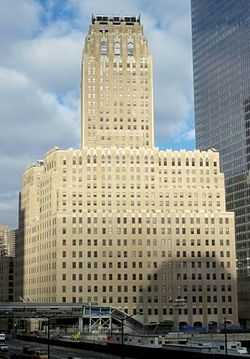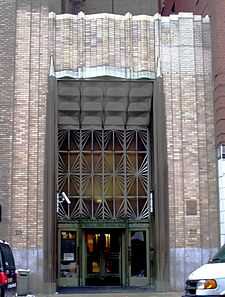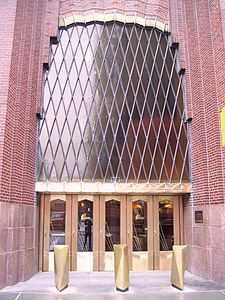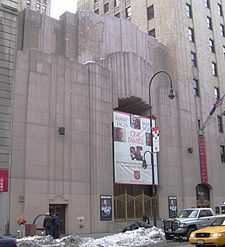Ralph Thomas Walker




Ralph Thomas Walker, FAIA, (1889–1973) was an American architect, president of the American Institute of Architects and partner of the firm McKenzie, Voorhees, Gmelin; and its successor firms Voorhees, Gmelin & Walker, Voorhees, Walker, Foley & Smith; Voorhees, Walker, Smith & Smith; and Voorhees, Walker, Smith, Smith & Haines.[1] Walker is best known for his designs for the Barclay-Vesey Telephone Building (1922–26) and the Irving Trust Building (1928–31).
Early life
Walker was born November 28, 1889 in Waterbury, Connecticut. He attended Classical High School in Providence, Rhode Island, and attended the architecture school at M.I.T. as a member of the class of 1911; he left during his final semester before graduating. He was a Rotch Traveling Scholar in 1916.[1] He married Stella Forbes, of Providence, in 1913.
Early career
In 1907, at the age of 18, Walker was apprenticed to Providence, Rhode Island architect Howard K. Hilton. The three-year apprenticeship paid one dollar a week for the first year, two a week for the second year and three a week for the third. While working there Walker attended classes at MIT and after two years had moved up to a design position, paying nine dollars a week.[1]
After leaving MIT in 1911, and before his service in World War I, Walker practiced in various offices in Boston, Montreal, and New York, "in charge of planning and design of churches, monumental buildings, universities and commercial buildings."[1]
Military service
Walker served as a second lieutenant of the Camouflage Section, Corps of Engineers, A.E.F., from 1917 to 1918.[1]
Career
In 1919 Walker took a position with McKenzie, Voorhees and Gmelin, a New York firm that was the successor firm to the one begun by Cyrus L. W. Eidlitz. Walker was to remain there for the remainder of his career.
In his first few years with the firm, Walker used his Beaux-Arts training to provide support for the firm's ongoing commissions for projects like the Brooklyn Municipal Building (completed 1924) and the Brooklyn Edison Company Building (completed 1923).
With his design for the Barclay-Vesey Telephone Building (1922–1926), Walker became a lead designer and took McKenzie, Voorhees and Gmelin in a new direction. The Barclay-Vesey Building, now known as the Verizon Building at 140 West Street in New York City, is credited as being the first skyscraper to use the New York 1916 Zoning Resolution as a design asset.[2] Inspired in part by Hugh Ferriss's theoretical drawings exhibited in 1922, Walker created a massive asymmetrical tower set back from its base. The design led the way for a generation of skyscrapers built using the set-back principle. It has also been described as the first art deco skyscraper because of its inventive ornament surrounding doorways and windows.[3] As a result of the success of the design, Walker made partner in the firm and its name was changed to Voorhees, Gmelin, and Walker in 1926.
After the completion of the Barclay-Vesey Telephone Building, Walker designed several other buildings using its combination of asymmetrical setbacks and towers with art deco ornament, including the Salvation Army Headquarters (1929–30) on West 14th Street, the Irving Trust Bank at 1 Wall Street (1928–31),[4] and several other telephone buildings throughout New York City and the state, including those in Syracuse and Rochester as well as the New Jersey Bell Headquarters Building.
During the 1930s as art deco waned, Walker was deeply involved with the planning of the 1933 Century of Progress Exposition in Chicago and in the 1939 New York World's Fair.
Walker was an active member of the American Institute of Architects (AIA) and became its president in 1949.[1] During his two-year presidency he was instrumental in establishing the AIA's College of Fellows which gained approval in 1952.[5] In 1957, on the occasion of the AIA's 100th anniversary, the AIA recognized Walker's extraordinary service to the profession by creating a special award for him, the AIA Centennial Medal of Honor (Gold Medal). The New York Times headline reporting the award dubbed Walker the "Architect of the Century."[6] To commemorate the event, Walker also wrote and published an autobiography.[7]
Walker retired from Voorhees, Walker, Foley, Smith & Smith in 1959 but remained active within the profession. Prior to his death, however, he destroyed his AIA award.[8] He killed himself in 1973, using a silver bullet that he had forged himself.[9]
Controversy
In 1960, Walker resigned from the AIA after a conflict over professional ethics. The AIA accused a member of Walker's firm of acting in an "unprofessional manner" by taking a contract that already belonged to another firm. Walker was devastated by the controversy and self-published a booklet defending his reputation—and including much of the correspondence surrounding the incident—which he sent to all members of the College of Fellows. He ended the essay with:
- May I say, finally, that I have no illusions of grandeur; quite to the contrary, I am very humble in my knowledge that through forty years of my life my life has been an open book of service to my fellow architects and for the public good. When I sever my connections with the A.I.A. I do so with my own self respect , as a matter of pride and I am sure within your knowledge of my character. I completely scorn the falsifying, the sanctimonious, the cheap and the shoddy.[10]
Walker was later reinstated to the AIA in 1965.
Other organizations
Walker belonged to several other organizations. He was appointed by President Dwight D. Eisenhower to the U.S. Commission of Fine Arts, serving from 1959 to 1963;[11] he was a trustee of the Lavanburg Foundation, Vice President of the Citizen's Housing & Planning Council of New York, and a member of the Housing Committee, and Chairman of the Planning Committee of New Castle, New York. In addition, he was a president of the Architectural League of New York, president of the Municipal American Society, New York City, and member of the American Institute of Planners, the American Society of Planning Officials, and the National Association of Housing Officials.[1]
Selected designs
(all in New York City unless otherwise indicated)
- The New York Telephone Company Building, aka the Barclay-Vesey Building and now the Verizon Building (1922–26) and badly damaged in the September 11, 2001 attacks.
- Western Union Building, now 60 Hudson Street (1928–30)
- Irving Trust Building, now One Wall Street (1928–31)
- New Jersey Bell Headquarters Building, Newark (1929)
- Salvation Army Headquarters, New York, NY (1929–30)
- New York Telephone Company Long Island Headquarters (1929–30), Brooklyn, NY, now converted to the BellTel Lofts (2006)
- Verizon Building (c.1930s), 212 West 18th Street, as of 2012 being converted to residential condominiums under the name "Walker Tower"
- Times Square Building, Rochester, New York (1930)
- AT&T Long Distance Building, 32 Sixth Avenue (1930–32)
- AT&T Pavilion, General Electric Pavilion, Borden Pavilion, Petroleum Pavilion, New York World's Fair (1939)
- Charles Hayden Memorial Library, MIT, Cambridge, Massachusetts (1946–51)
References
- Notes
- ↑ 1.0 1.1 1.2 1.3 1.4 1.5 1.6 "Questionnaire for Architects' Roster and/or Register of Architects Qualified for Federal Works" 26 September 1946
- ↑ Robert A. M. Stern, Patrick Gilmartin & Thomas Mellins. New York 1930: Architecture and Urbanism Between the Two World Wars. New York: Rizzoli International Publications, 1987.
- ↑ Cervin Robinson and Rosemarie Haag Bletter, Skyscraper Style: Art Deco New York. Oxford University Press, 1977.
- ↑ Daniel Abramson, Skyscraper Rivals. New York: Princeton Architectural Press, 2000.
- ↑ American Institute of Architects, The History and Directory of the College of Fellows Washington, D.C.: AIA, 2007.
- ↑ "Architect of the Century: Ralph Thomas Walker," New York Times, May 10, 1957, page 26.
- ↑ Ralph Walker. Ralph Walker: Architect. New York: Henahan House, 1957.
- ↑ Drumm, Perrin (6 April 2012). "Ralph Walker: America's Most Underrated Architect". Core77. Retrieved 5 January 2013.
- ↑ Sheftell, Jason (3 January 2013). "A-listers flock to Walker Tower, a 1929 Art Deco fortess-like luxury condo in Chelsea". New York Daily News. Retrieved 5 January 2013.
- ↑ Ralph Walker; The American Institute of Architects - 1921 - 1961, New York, 1961.
- ↑ Thomas E. Luebke, ed., Civic Art: A Centennial History of the U.S. Commission of Fine Arts (Washington, D.C.: U.S. Commission of Fine Arts, 2013): Appendix B, p. 556.
External links
 Media related to Ralph Thomas Walker at Wikimedia Commons
Media related to Ralph Thomas Walker at Wikimedia Commons- "Ralph Walker: Architect of the Century"
|